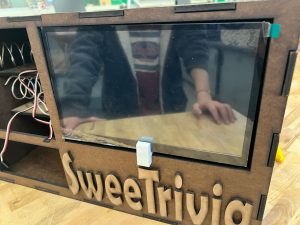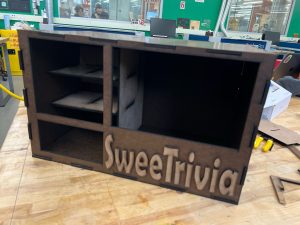- What are the most significant risks that could jeopardize the success of the project? How are these risks being managed? What contingency plans are ready? (written by Vicky)
=> Our most significant risk this week:
- Audio output: Getting the speaker on the rpi touchscreen to play the game’s audio narration. There seems to be an audio signal transmission problem from the rpi to the screen and the built-in speakers are not able to output sound. We managed this risk by using an external bluetooth speaker which worked well and the size of the speaker was suitable to be enclosed in the machine box behind the screen.
- Kiosk display: Initially we configured the rpi to boot up in kiosk mode by making a run_kiosk.sh file and modifying the wayfire.ini inside .config. However this will only work with a deployed website, not with our current React app. We managed this by using command line kiosk mode inside chromium and the view had the same effect.
- Mechanical assembly: We encountered some laser cutting challenges.
- The purchased wood material size is slightly narrower than the initial design. We managed this by modifying the box height (see question 2).
- Attaching the screen to the box: initially we wanted to make one 3D printed slider that covers the entire length of the cut-out screen space on the front panel. This did not work because there is not enough space to tilt the holder and install the screen. We managed this by changing the design to make two screen corner holders with narrow bottom gaps that tightly sit on the front panel.
- Error margins that made the cut result deviate slightly from the design file. This may be caused by: the vibration of the laser cutter working table caused the material to move and the laser trace inaccurately. This was managed by using maximum laser power to minimize the number of total cut rounds. (One round of cut was still unrealistic because of the ¼ inch thickness)
2. Were any changes made to the existing design of the system (requirements, block diagram, system spec, etc)? Why was this change necessary, what costs does the change incur, and how will these costs be mitigated going forward? (written by Fei)
=>There were a couple of changes made to the existing design, including switching the SweetTrivia letters from etching to 3D, redesigning the shape of the screen holder, and reducing the CAD box height from 11.8 inches to 11 inches. These modifications were necessary to enhance aesthetics and improve functionality. Initially, we designed the screen holder to be the same length as the screen to not only support it but also hide the gap between the screen and the hole cut for it. However, after discussion, we realized that due to the inflexibility of the 3D printing material, fitting the screen might become difficult if the holder was the exact same length. As a result, we prioritized functionality over aesthetics and adjusted the design accordingly. Similarly, the box height was originally set to 11.8 inches to match the dimension of our wood board, but during laser cutting, we found it impossible to achieve that level of precision, so we adjusted it to 11 inches, slightly reducing the height without sacrificing too much space. These changes incurred costs related to design revisions and potential material waste. To mitigate these costs, we carefully reviewed every print file before sending it to the laser cutter and ensured the first prototype worked before printing the remaining parts.
3. Provide an updated schedule if changes have occurred. This is also the place to put some photos of your progress or to brag about a component you got working. (written by Min Ji)
=> no big changes in the schedule. Our group is planning to develop parts beyond our MVP after the demo. Attached are some pictures of the vending machine box.


